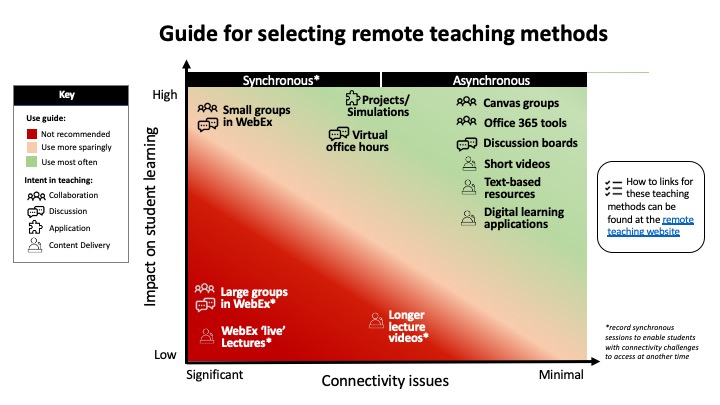As you consider how to deliver your course remotely for the fall term you may be weighing the pros and cons of synchronous vs. asynchronous content. In this post we hope to persuade you towards a mostly asynchronous course design that will help ensure equitable access to materials and a more flexible environment for students to work with. After all, remote learning is not only new for faculty and instructors, but many of our students as well.
Consider the Infographic below
![]() Requirements for a synchronous lecture can often inhibit active participation by some students. Technology factors alone can contribute to a gap between students who have and those who have not, but there are many reasons why synchronous meetings can be tough. Consider a student who
Requirements for a synchronous lecture can often inhibit active participation by some students. Technology factors alone can contribute to a gap between students who have and those who have not, but there are many reasons why synchronous meetings can be tough. Consider a student who
-
- does not have a computer equipped with a camera or microphone
- has spotty internet or is using WiFi hot spots from cafes or their phone’s data network to connect
- is a single parent with young children at home
- shares living spaces with numerous roommates
- is in a different timezone from the lecturer
- is working a full time job while trying to complete their studies.
These students can be adversely affected by a required and scheduled, streaming, online, synchronous, delivery method.
![]() Asynchronous delivery strategies create a more flexible environment for students to organize their time within. Giving students weekly modules of content in which to work through and providing asynchronous opportunities to connect with peers and instructors through activity-based discussions and group work will keep them connected to the course community and provide them with the support they need to succeed. So how can you design and develop your lectures and course materials into effective asynchronous learning modules?
Asynchronous delivery strategies create a more flexible environment for students to organize their time within. Giving students weekly modules of content in which to work through and providing asynchronous opportunities to connect with peers and instructors through activity-based discussions and group work will keep them connected to the course community and provide them with the support they need to succeed. So how can you design and develop your lectures and course materials into effective asynchronous learning modules?
Let’s take a look.
First, think about the content of you lecture and try and identify the specific topics you discuss.
- For each topic write a short introduction in a conversational tone to get students familiar with the major concepts.
- From there you might provide an embedded YouTube video to further explain a concept with some visual aids.
- Remember to write a short introduction to the video to explain why it’s being included as learning material and how it connects to the topics and concepts.
- Now provide some context about your topic or concept that might give students a sense of real world applications or connections to current world events. How is this topic relevant today?
- Finally let’s make sure that students have an active opportunities to test their knowledge and apply their learning. Discussions, web quests, reflections or at the very least some review questions and answers will provide them with the formative self assessment they need to know they’re on the right track.
Repeat this process for each of the topics within a module until you have what you feel is an adequate learning experience for that week.
The structure of this prototype module can now be followed for each week worth of content creating modules for the full term.
Resources to help guide the Module development process:
Don’t forget to provide clear ways for students to connect with you and their peers. Asynchronous DOES NOT mean building a course that should be completed in isolation. It simply means allowing for the student to have flexible control of how and when they engage with the materials, discussions and activities you’ve designed.
See a previous blog post for ideas on connecting with students throughout the term.
And how to promote peer to peer interactions within your asynchronous course.



